Water Management Strategies and Yield Response in Pecan Orchards: A Comparative Analysis of Irrigation Systems
Abstract
1. Introduction
2. Materials and Methods
2.1. Study Area and Climate
2.2. Experiment Set Up
2.2.1. Precipitation
2.2.2. Irrigation
2.2.3. Volumetric Soil Water Content
2.2.4. Evapotranspiration
2.2.5. Groundwater Level
2.3. Crop Yield and Statistical Analysis
3. Results
3.1. Precipitation and Irrigation
3.2. Change in Volumetric Soil Water Content
3.3. Evapotranspiration and Recharge
3.4. Crop Yield and Statistical Analysis
4. Discussion
4.1. Change in Volumetric Soil Water Content
4.2. Groundwater Recharge
4.3. Crop Yield and Water Productivity
4.4. Implications for Sustainability
5. Conclusions
Author Contributions
Funding
Data Availability Statement
Acknowledgments
Conflicts of Interest
References
- Zhang, K.; Li, X.; Zheng, D.; Zhang, L.; Zhu, G. Estimation of Global Irrigation Water Use by the Integration of Multiple Satellite Observations. Water Resour. Res. 2022, 58, e2021WR030031. [Google Scholar] [CrossRef]
- Lovelace, J.K.; Nielsen, M.G.; Read, A.L.; Murphy, C.J.; Maupin, M.A. Estimated Groundwater Withdrawals from Principal Aquifers in the United States, 2015, Version 1.2; Circular 1464; U.S. Geological Survey: Nashville, TN, USA, 2020; p. 70. [CrossRef]
- United States Department of Agriculture. Census of Agriculture; National Agricultural Statistics Service (NASS): Washington, DC, USA. Available online: https://www.nass.usda.gov/ (accessed on 15 August 2023).
- Ibraimo, N.A.; Taylor, N.J.; Steyn, J.M.; Gush, M.B.; Annandale, J.G. Estimating water use of mature pecan orchards: A six stage crop growth curve approach. Agric. Water Manag. 2016, 177, 359–368. [Google Scholar] [CrossRef]
- Stein, L.A.; McEachern, G.R.; Storey, J.B. Summer and Fall Moisture Stress and Irrigation Scheduling Influence Pecan Growth and Production. HortScience 1989, 24, 607–611. [Google Scholar] [CrossRef]
- Worley, R.E. Tree Yield and Nut Characteristics of Pecan with Drip Irrigation under Humid Conditions. J. Am. Soc. Hortic. Sci. 1982, 107, 30–34. [Google Scholar] [CrossRef]
- Wells, L. Irrigation Water Management for Pecans in Humid Climates. HortScience 2015, 50, 1070–1074. [Google Scholar] [CrossRef]
- Miyamoto, S. Consumptive Water Use of Irrigated Pecans. Am. Soc. Hortic. Sci. 1983, 108, 676–681. [Google Scholar] [CrossRef]
- Sammis, T.W.; Mexal, J.G.; Miller, D. Evapotranspiration of flood-irrigated pecans. Agric. Water Manag. 2004, 69, 179–190. [Google Scholar] [CrossRef]
- Simmons, L.J.; Wang, J.; Sammis, T.W.; Miller, D.R. An evaluation of two inexpensive energy-balance techniques for measuring water use in flood-irrigated pecans (Carya illinoinensis). Agric. Water Manag. 2007, 88, 181–191. [Google Scholar] [CrossRef]
- Rodríguez, J.C.; Er-Raki, S.; Cruz-Bautista, F.; Meddich, A.; Lizárraga-Celaya, C.; Castellaños-Villegas, A.E.; Ochoa-Meza, A. Annual evapotranspiration of pecan trees in an arid and hot zone in Mexico. Acta Hortic. 2025, 1420, 85–94. [Google Scholar] [CrossRef]
- Rodriguez, J.C.; Grageda, J.; Watts, C.J.; Garatuza-Payan, J.; Castellanos-Villegas, A.; Rodriguez-Casas, J.; Olavarrieta, V. Water use by perennial crops in the lower Sonora watershed. Arid. Environ. 2010, 74, 603–610. [Google Scholar] [CrossRef]
- Skaggs, R.; Samani, Z.; Bawazir, S.A.; Bleiweiss, M. The Coverage of Water Rights, Structural Change, Technology, and Hydrology: A Case Study of New Mexico’s Lower Rio Grande. Nat. Resour. J. 2011, 51, 95–117. [Google Scholar]
- Boyko, K.; Fernald, A.G.; Bawazir, A.S. Improving groundwater recharge estimates in alfalfa fields of New Mexico with actual evapotranspiration measurements. Agric. Water Manag. 2021, 244, 106532. [Google Scholar] [CrossRef]
- Ochoa, C.G.; Fernald, A.G.; Guldan, S.J.; Tidwell, V.C.; Shukla, M.K. Shallow aquifer recharge from irrigation in a semiarid agricultural valley in New Mexico. J. Hydrol. Eng. 2013, 18, 1219–1230. [Google Scholar] [CrossRef]
- Abudu, S.; Sheng, Z.; Michelsen, A.; Rodriguez, O.; King, J. Evapotranspiration and Crop Coefficient for Pecan Trees in El Paso, Texas. In Proceedings of the 2016 Irrigation Show & Education Conference, Las Vegas, NV, USA, 5 December 2016. [Google Scholar]
- Sheng, Z.; Liu, Y. Evapotranspiration of flood-irrigated pecans under drought conditions in El Paso, TX. In Proceedings of the 2015 ASABE/IA Irrigation Symposium: Emerging Technologies for Sustainable Irrigation, Long Beach, CA, USA, 9–11 November 2015. [Google Scholar] [CrossRef]
- Wang, J.; Sammis, T.W.; Meier, C.A.; Simmons, L.J.; Miller, D.R.; Samani, Z. A modified SEBAL model for spatially estimating pecan consumptive water use for Las Cruces, New Mexico. In Proceedings of the 15th Conference on Applied Climatology, Des Moines, IA, USA, 20 June 2005; pp. 1–9. [Google Scholar]
- Palmate, S.S.; Kumar, S.; Poulose, T.; Ganjegunte, G.K.; Chaganti, V.N.; Sheng, Z. Comparing the Effect of Different Irrigation Water Scenarios on Arid Region Pecan Orchard Using a System Dynamics Approach. Agric. Water Manag. 2022, 265, 107547. [Google Scholar] [CrossRef]
- Deb, S.; Shukla, M.K.; Mexal, J. Simulating Deep Percolation in Flood-Irrigated Mature Pecan Orchards with RZWQM2. ASABE 2012, 55, 2089–2100. [Google Scholar] [CrossRef]
- Preciado, J.; Fernald, A.; Heerema, R.; Pierce, C. Enhancing crop water productivity and aquifer recharge in arid regions: Water balance insights for optimized hybrid irrigation in pecan orchards. Agric. Water Manag. 2025, 315, 109564. [Google Scholar] [CrossRef]
- Conover, C.S. Ground-Water Conditions in the Rincon and Mesilla Valleys and Adjacent Areas in New Mexico; Water Supply Paper 1230; US Government Printing Office: Washington, DC, USA; US Geological Survey Water-Supply: Reston, VA, USA, 1954.
- Malm, N.R. Climate Guide: Las Cruces, 1892–2000; Research report No. 749; New Mexico State University: Las Cruces, NM, USA, 2003. [Google Scholar]
- LeRoy, S.; Garfin, G. The Climate of Las Cruces, New Mexico. In Climate Assessment for the Southwest; University of Arizona: Tucson, AZ, USA, 2017. [Google Scholar]
- Manoj, S.K. Soil Physics: An Introduction, 2nd ed.; CRC Press: Boca Raton, FL, USA, 2023; pp. 89–96. [Google Scholar] [CrossRef]
- Sorensen, R.B.; Jones, T.L. Soil Water Uptake Patterns of Pecan Trees Grown in Coarse Gravelly Soils. HortTechnology 1999, 9, 402–408. [Google Scholar] [CrossRef]
- Wang, J.; Sammis, T.W.; Andales, A.A.; Simmons, L.J.; Gutschick, V.P.; Miller, D.R. Crop coefficients of open-canopy pecan orchards. Agric. Water Manag. 2007, 88, 253–262. [Google Scholar] [CrossRef]
- Elephant Butte Irrigation District. Retrieved from EBID Water Data. Available online: https://www.ebid-nm.org/ (accessed on 16 February 2022).
- Conner, P.J.; Worley, R.E. Alternate Bearing Intensity of Pecan Cultivars. HortScience 2000, 35, 1067–1069. [Google Scholar] [CrossRef]
- Arnold, L.R. Estimates of Deep-Percolation Return Flow Beneath a Flood- and a Sprinkler-Irrigated Site in Weld County, Colorado, 2008–2009 (Report 2011–5001); U.S. Geological Survey Scientific Investigations; USGS: Reston, VA, USA, 2011.
- Li, Z.; Zong, R.; Wang, T.; Wang, Z.; Zhang, J. Adapting Root Distribution and Improving Water Use Efficiency via Drip Irrigation in Jujube (Zizyphus jujube Mill.) Orchard after Long-Term Flood Irrigation. Agriculture 2021, 11, 1184. [Google Scholar] [CrossRef]
- Bachofen, C.; Tumber-Davila, S.J.; Mackay, D.S.; McDowell, N.G.; Carminati, A.; Klein, T.; Grossiord, C. Tree water uptake patterns across the globe. New Phytol. 2024, 242, 1891–1910. [Google Scholar] [CrossRef]
- Porhemmat, J.; Nakhaei, M.; Dadgar, M.A.; Biswas, A. Investigating the effects of irrigation methods on potential groundwater recharge: A case study of semiarid regions in Iran. Hydrology 2018, 565, 455–466. [Google Scholar] [CrossRef]
- Attou, T.; Kuppel, S.; Kharrou, M.H.; Ezzahar, J.; Bouchaou, L.; Brahim, Y.A.; Chehbouni, A. A process-based modelling of groundwater recharge under contrasting irrigation methods in semi-arid crops. Agric. Water Manag. 2025, 316, 109584. [Google Scholar] [CrossRef]
- Gutierrez-Jurado, K.Y.; Fernald, A.G.; Guldan, S.J.; Ochoa, C.G. Surface Water and Groundwater Interactions in Traditionally Irrigated Fields in Northern New Mexico, USA. Water 2017, 9, 102. [Google Scholar] [CrossRef]
- Grafton, R.Q.; Williams, J.; Perry, C.J.; Molle, F.; Ringler, C.; Steduto, P.; Allen, R.G. The Paradox of Irrigation Efficiency, Higher Efficiency Rarely Reduces Water Consumption. Science 2018, 361, 748–750. [Google Scholar] [CrossRef] [PubMed]
- Playan, E.; Mateos, L. Modernization and Optimization of Irrigation Systems to Increase Water Productivity. Agric. Water Manag. 2006, 80, 100–116. [Google Scholar] [CrossRef]
- Pereira da Silva, A.J.; Ferreira, E. Estimation of Water Percolation by Different Methods Using TDR. Rev. Bras. Cienc. Solo 2014, 38, 73–81. [Google Scholar] [CrossRef]
- Zermeño-Gonzalez, A.; Escalante-Perez, A.; Gil-Marin, J.A.; Ramirez-Rodriguez, H.; Cadena-Zapata, M.; Melendres-Alvarez, A.I.; Mendez-Gonzalez, J. Determination of the Water use Efficiency of a Pecan Nut Orchard based on the Irrigation Scheduling and the Evapotranspiration Rate in Northen Mexico. Open Biotechnol. J. 2023, 17, e187407072307180. [Google Scholar] [CrossRef]
- Andales, A.; Wang, J.; Sammis, T.W.; Mexal, J.G.; Simmons, L.J.; Miller, D.R.; Gutschick, V.P. A model of pecan tree growth for the management of pruning and irrigation. Agric. Water Manag. 2006, 84, 77–88. [Google Scholar] [CrossRef]
- Kallestad, J.C.; Sammis, T.W.; Mexal, J.G.; White, J. Monitoring and Management of Pecan Orchard Irrigation: A Case Study. HorTechnology 2006, 16, 667–673. [Google Scholar] [CrossRef]
- Liu, Y.; Sheng, Z. Soil Moisture Status in an Irrigated Pecan Field. Am. Soc. Civ. Eng. 2013, 139, 26–40. [Google Scholar] [CrossRef]
- Sammis, T.W.; Shukla, M.K.; Mexal, J.G.; Wang, J.; Miller, D.R. Pecan Research and Outreach in New Mexico: Logic Model Development and Change in Communication Paradigms. J. High. Educ. Outreach Engagem. 2013, 17, 27–41. [Google Scholar]
- Maguire, M.S.; Neale, C.M.; Woldt, W.E.; Heeren, D.M. Managing spatial irrigation using remote sensing-based evapotranspiration and soil water adaptive control model. Agric. Water Manag. 2022, 272, 107838. [Google Scholar] [CrossRef]
- Eslamifar, G.; Balali, H.; Fernald, A. Fallowing Strategy and Its Impact on Surface Water and Groundwater Withdrawal, and Agricultural Economics: A System Dynamics Approach in Southern New Mexico. Water 2024, 16, 181. [Google Scholar] [CrossRef]
- Silber-Coats, N.; Elias, E.; Fernald, K.; Gagliardi, M. Evaluating alternative crops as a solution to water stress in the US. Southwest. Agric. Water Manag. 2025, 312, 109439. [Google Scholar] [CrossRef]
- Escriva-Bou, A.; Medellin-Azuara, J.; Hanak, E.; Abatzoglou, J.; Viers, J. Public Policy Institute of California: Drought and California’s Agriculture. April 2022. Available online: https://www.ppic.org/publication/policy-brief-drought-and-californias-agriculture/ (accessed on 15 August 2025).
- Brookshire, D.S.; Gupta, H.V.; Matthews, O.P. Water Policy in New Mexico: Addressing the Challenge of an Uncertain Future; RFF Press: Washington, DC, USA, 2012. [Google Scholar]
- Hatfield, J.L.; Dold, C. Water-Use Efficiency: Advances and Challenges in a Changing Climate. Front. Plant Sci. 2019, 10, 103. [Google Scholar] [CrossRef]
- Chavarria, S.B.; Gutzler, D.S. Observed changes in climate and streamflow in the upper Rio Grande basin. JAWRA 2018, 54, 644–659. [Google Scholar] [CrossRef]
- Chai, Q.; Qin, A.; Gan, Y.; Yu, A. Higher yield and lower carbon emission by intercropping maize with rape, pea, and wheat in arid irrigation areas. Agron. Sustain. Dev. 2014, 34, 535–543. [Google Scholar] [CrossRef]
- Garcia-Vasquez, A.C.; Granados-Olivas, A.; Samani, Z.; Fernald, A. Investigation of the Origin of Hueco Bolson and Mesilla Basin Aquifers (US and Mexico) with Isotopic Data Analysis. Water 2022, 14, 526. [Google Scholar] [CrossRef]
- Dai, A. Drought under global warming: A review. WIREs Clim. Change 2011, 2, 45–65. [Google Scholar] [CrossRef]
- Schewe, J.; Heinke, J.; Gerten, D.; Haddeland, I.; Arnell, N.W.; Clark, D.B.; Kabat, P. Multimodel assessment of water scarcity under climate change. Proc. Natl. Acad. Sci. USA 2014, 111, 3245–3250. [Google Scholar] [CrossRef]
- Vautard, R.; Gobiet, A.; Sobolowski, S.; Kjellstrom, E.; Stegehuis, A.; Watkiss, P.; Jacob, D. The European climate under a 2 C global warming. Environ. Res. Lett. 2014, 9, 034006. [Google Scholar] [CrossRef]
- Mu, J.E.; Ziolkowska, J.R. An integrated approach to project environmental sustainability under future climate variability: An application to U.S. Rio Grande Basin. Ecol. Indic. 2018, 95, 654–662. [Google Scholar] [CrossRef]
- Zhang, X. Conjunctive surface water and groundwater management under climate change. Front. Environ. Sci. 2015, 3, 59. [Google Scholar] [CrossRef]


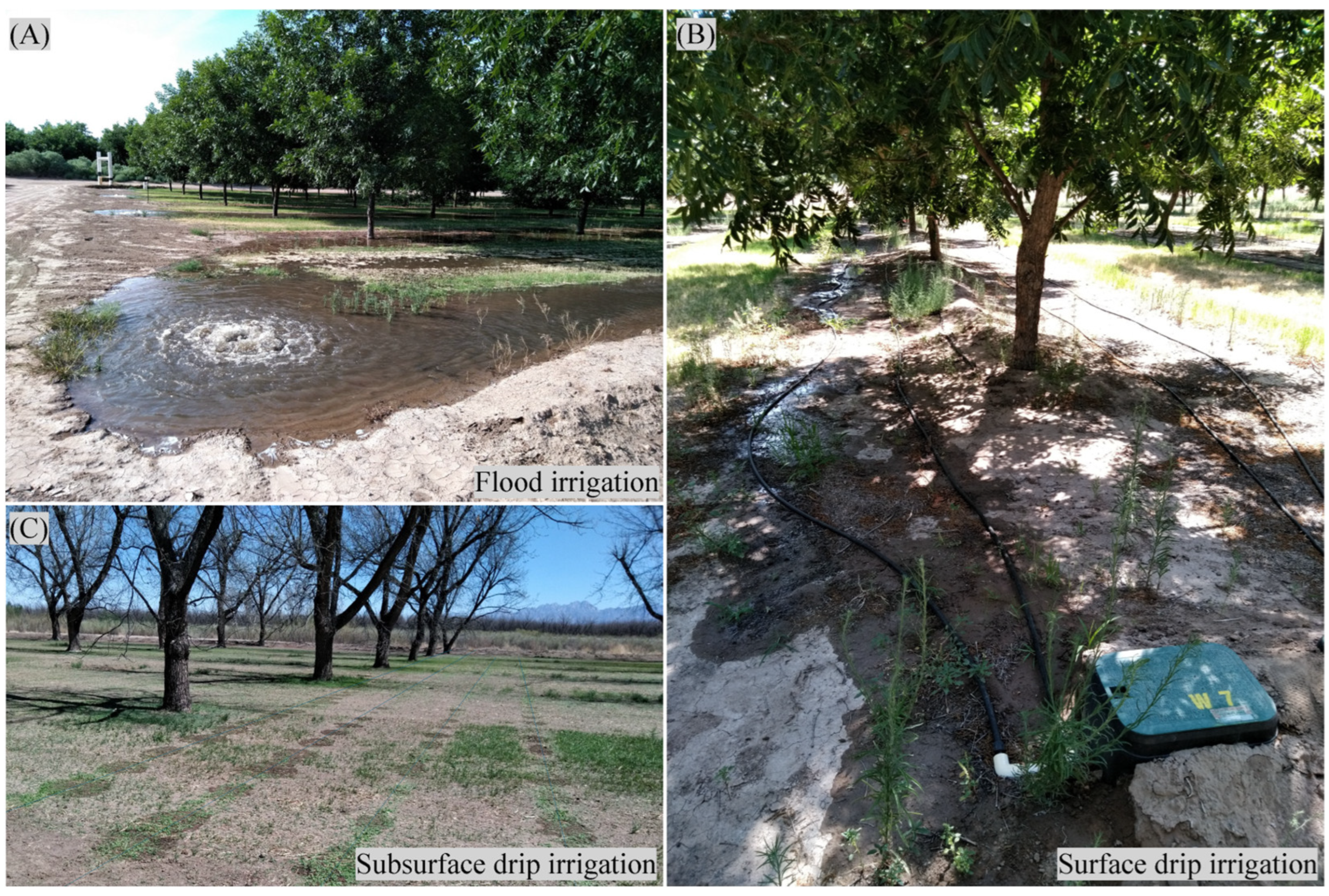
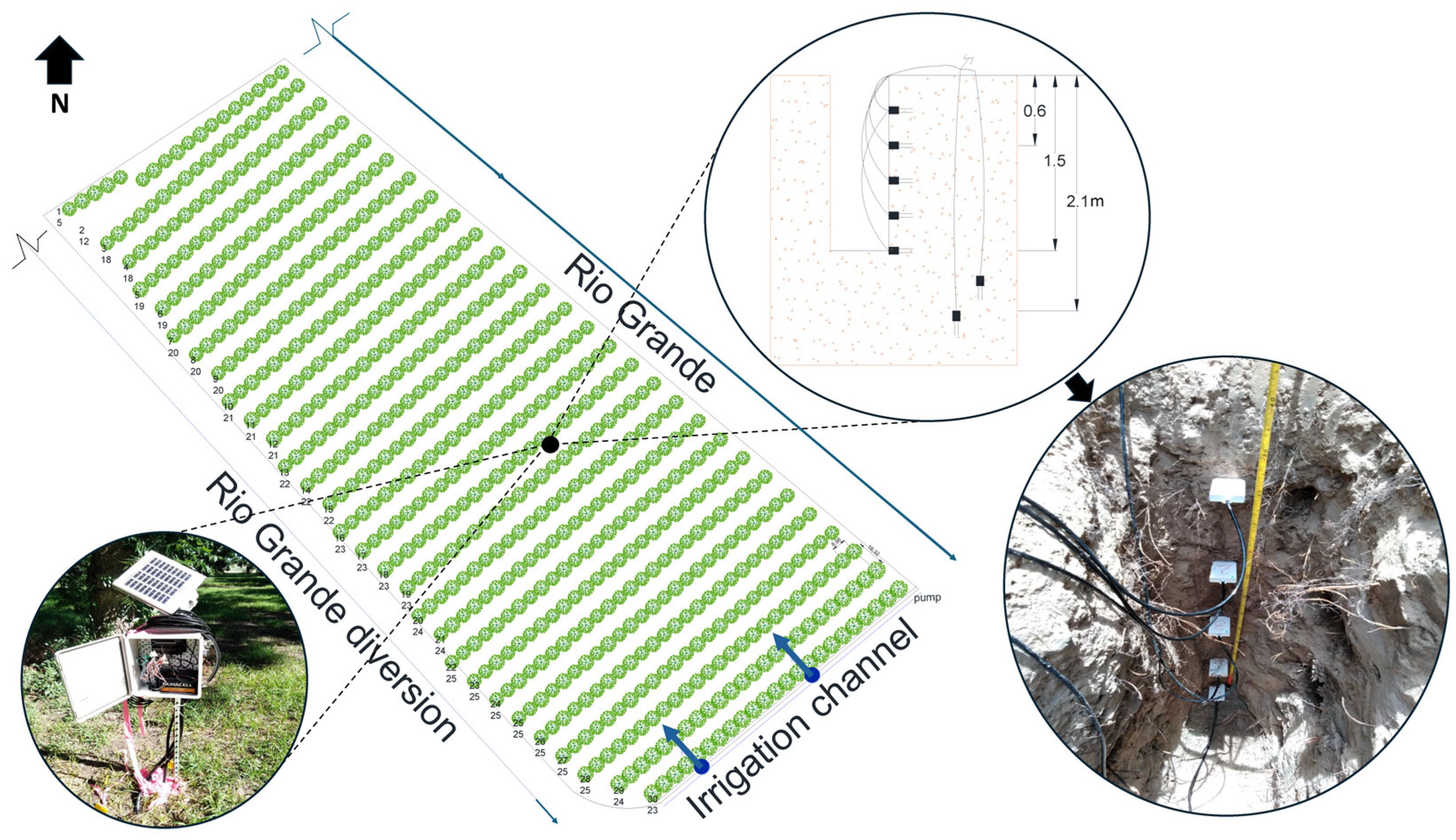
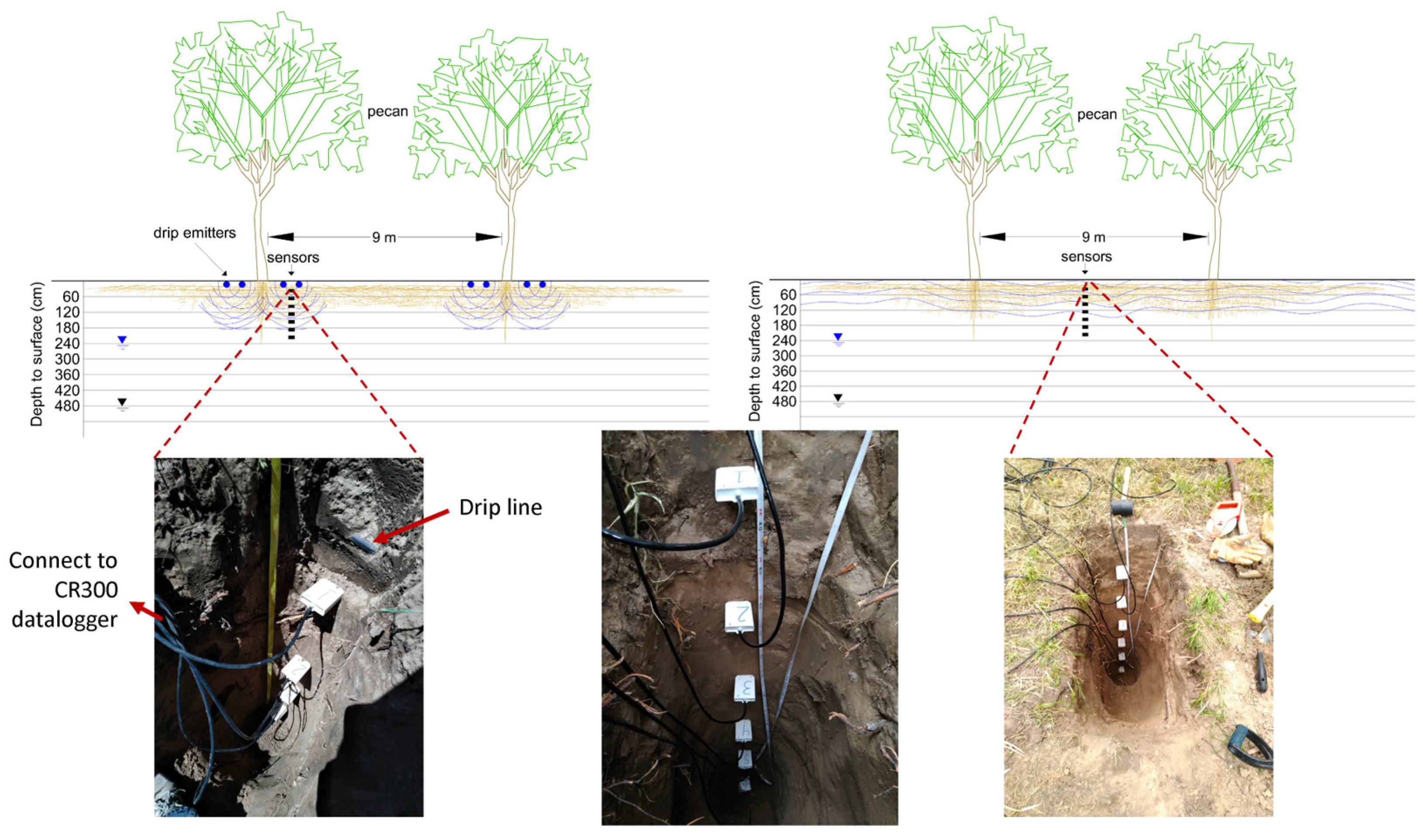
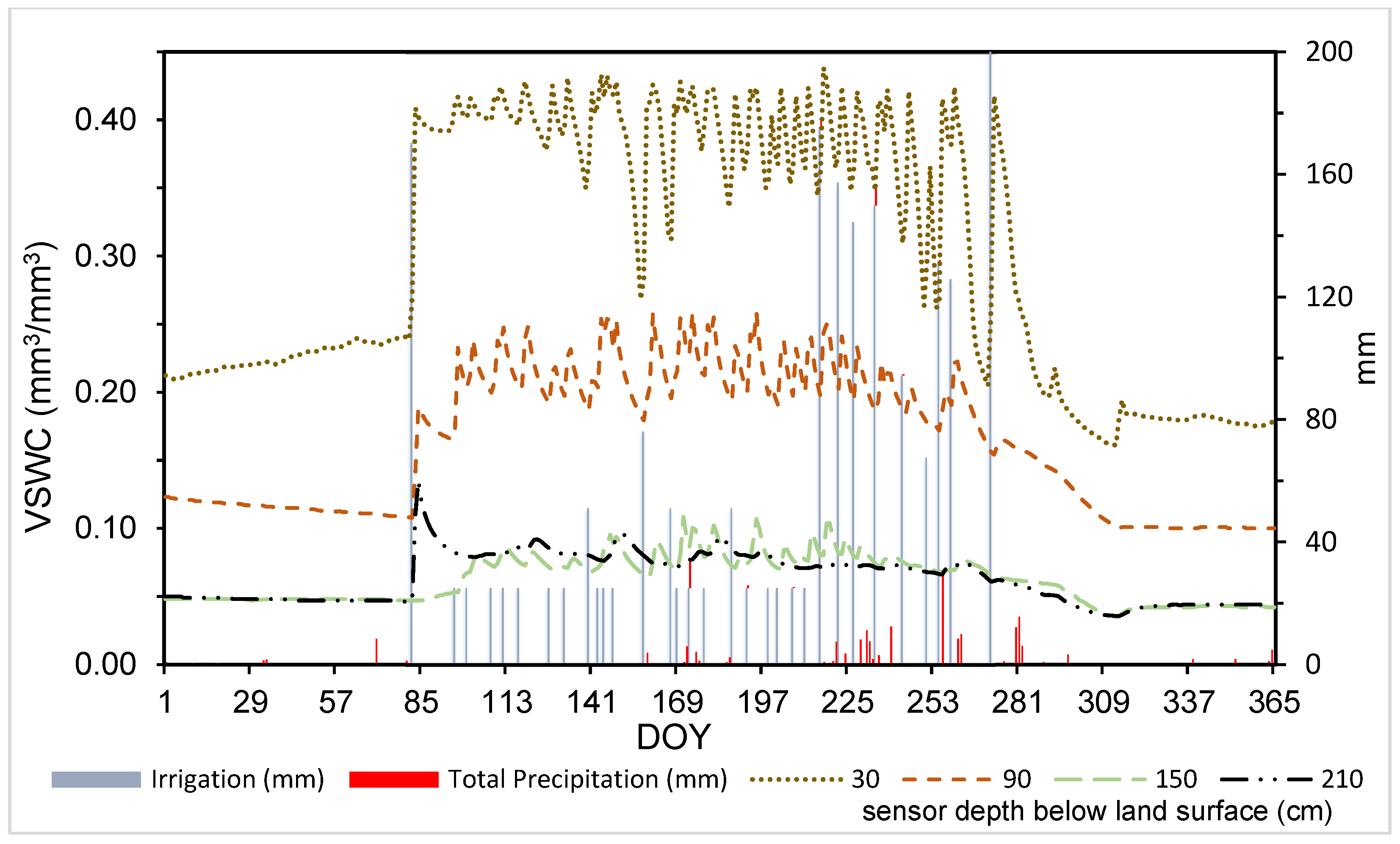
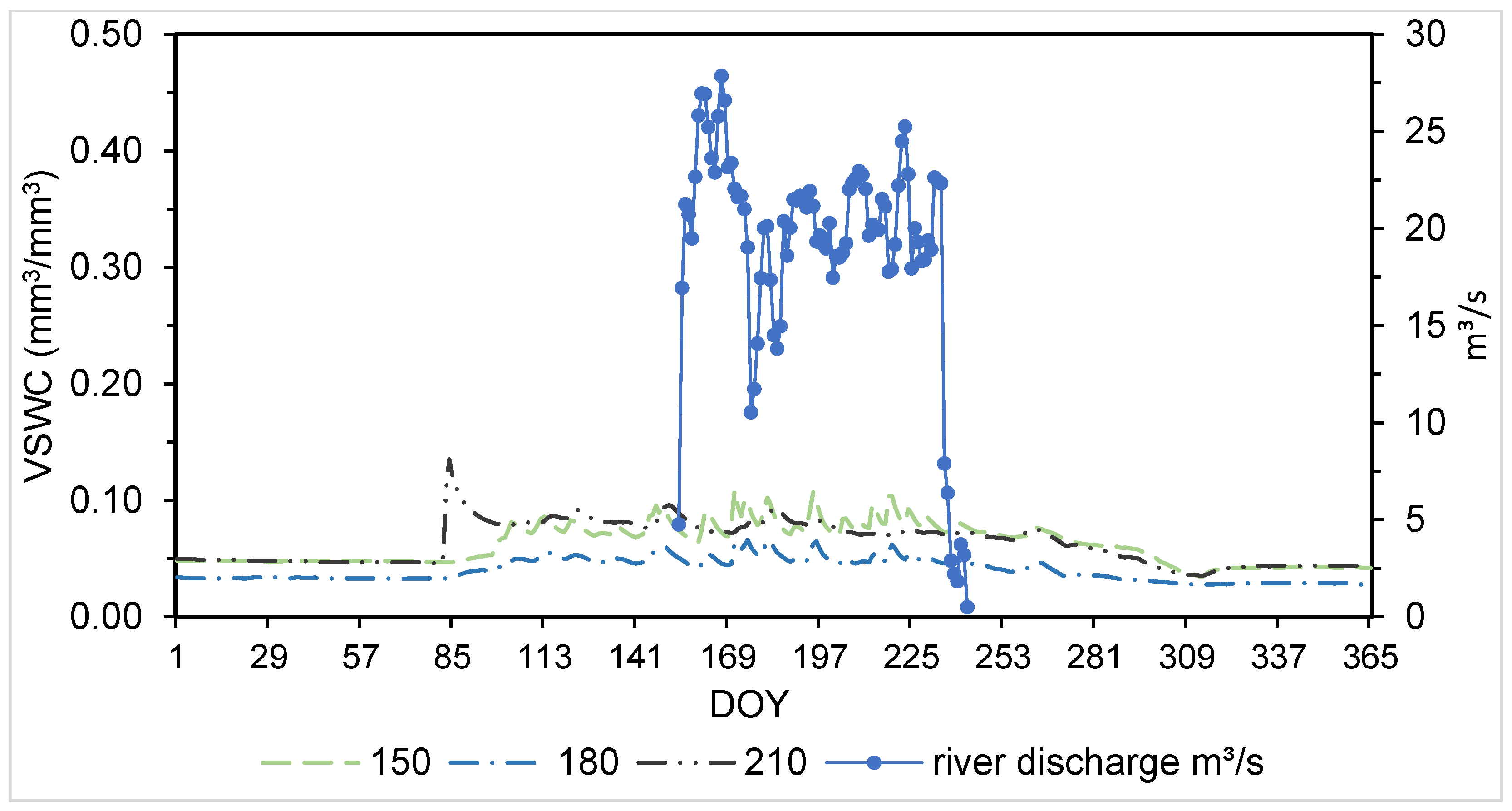
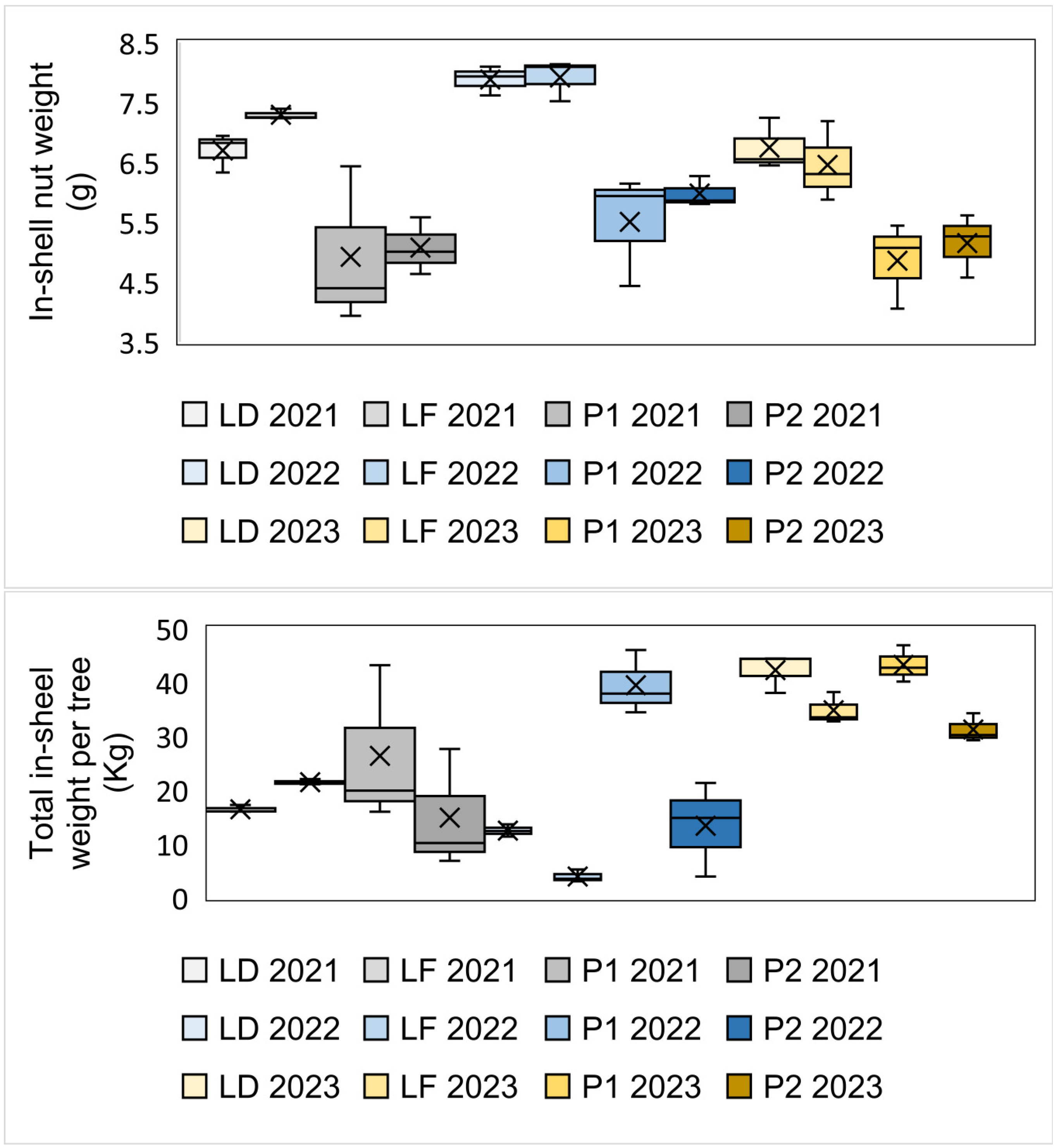
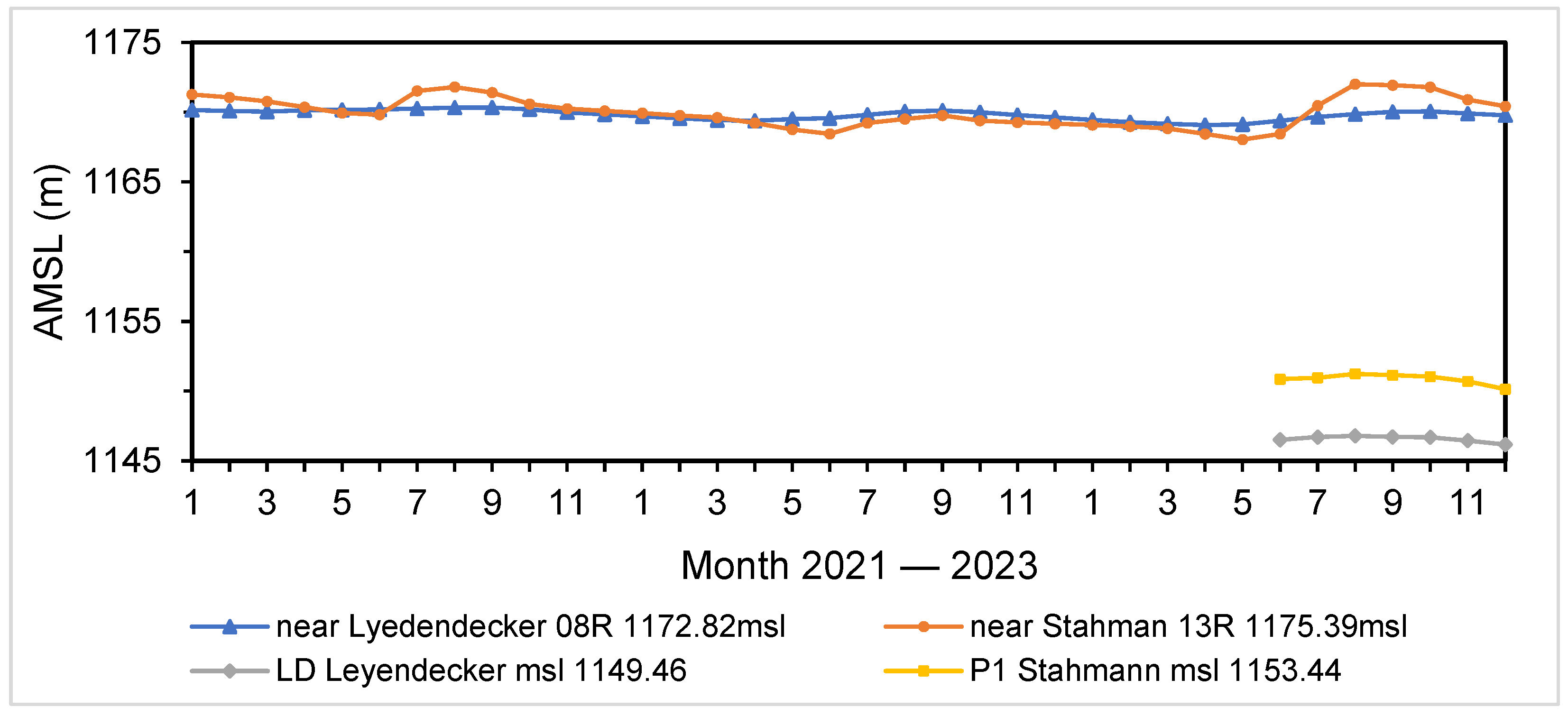
| Name | Location Latitude, Longitude | Elevation AMSL (m) | Area (ha) | Distance to Rio Grande (m) | Irrigation Type |
|---|---|---|---|---|---|
| Leyendecker Drip (LD) | 32°11′35″ N, 106°44′ 15″ W | 1149 | 2.42 | 110 | surface drip |
| Leyendecker Flood (LF) | 32°11′35″ N, 106°44′12″ W | 1149 | 1.61 | 115 | flood |
| Stahmann Orchard (P1) | 32°13′09″ N, 106°47′18″ W | 1153 | 10.52 | 135 | Flood (1 year)/subsurface drip (2 years) |
| Stahmann Orchard (P2) | 32°13′ 01″ N, 106°47′11″ W | 1153 | 6.07 | 120 | subsurface drip |
| Event | Irrigation Date d/m/y | Days | Irrigation (mm) | Rainfall (mm) | ETc (mm) | Δ Storage (mm) | Recharge (mm) |
|---|---|---|---|---|---|---|---|
| 1 | 14/3/2023 | 73 | 62 | 7 | 92 | 23 | −46 |
| 2 | 27/3/2023 | 13 | 109 | 4 | 16 | 15 | 81 |
| 3 | 4/4/2023 | 8 | 114 | 0 | 12 | 0 | 103 |
| 4 | 5/4/2023 | 1 | 139 | 0 | 1 | 62 | 76 |
| 5 | 1/5/2023 | 26 | 56 | 0 | 73 | 7 | −24 |
| 6 | 6/5/2023 | 5 | 48 | 0 | 20 | 5 | 23 |
| 7 | 11/5/2023 | 5 | 51 | 0 | 23 | 5 | 23 |
| 8 | 19/5/2023 | 8 | 43 | 2 | 36 | 5 | 4 |
| 9 | 25/5/2023 | 6 | 40 | 14 | 29 | 0 | 25 |
| 10 | 7/6/2023 | 13 | 34 | 0 | 72 | 8 | −45 |
| 11 | 16/6/2023 | 9 | 123 | 0 | 59 | 11 | 53 |
| 12 | 29/6/2023 | 13 | 67 | 0 | 86 | 1 | −19 |
| 13 | 7/7/2023 | 8 | 48 | 6 | 53 | 4 | −3 |
| 14 | 12/7/2023 | 5 | 108 | 1 | 34 | −4 | 79 |
| 15 | 20/7/2023 | 8 | 166 | 2 | 52 | −2 | 118 |
| 16 | 25/7/2023 | 5 | 97 | 0 | 33 | 2 | 62 |
| 17 | 2/8/2023 | 8 | 85 | 8 | 52 | 8 | 32 |
| 18 | 14/8/2023 | 12 | 115 | 4 | 82 | −3 | 39 |
| 19 | 17/8/2023 | 3 | 18 | 18 | 18 | 2 | 16 |
| 20 | 22/8/2023 | 5 | 44 | 0 | 37 | 7 | 0 |
| 21 | 28/8/2023 | 6 | 121 | 3 | 29 | 12 | 83 |
| 22 | 1/9/2023 | 4 | 63 | 0 | 21 | −4 | 46 |
| 23 | 17/9/2023 | 16 | 26 | 6 | 78 | 8 | −53 |
| 24 | 11/10/2023 | 24 | 47 | 9 | 106 | 4 | −53 |
| Total | 284 | 1823 | 84 | 1114 | 174 | 618 | |
| Mean | 12 | 76 | 3 | 46 | 7 | 26 |
| Orchard | Soil Depth (cm) | Bulk Density (g/cm3) | Sand (%) | Clay (%) | Silt (%) | Soil Texture |
|---|---|---|---|---|---|---|
| Leyendecker | 30 | 1.42 | 59 | 21 | 20 | sandy clay loam |
| 60 | 1.35 | 39 | 31 | 30 | clay loam | |
| 90 | 1.41 | 57 | 19 | 24 | sandy loam | |
| 120 | 1.42 | 75 | 15 | 9 | sandy loam | |
| 150 | - | 79 | 18 | 3 | sandy loam | |
| 180 | - | 80 | 17 | 2 | sandy loam | |
| 210 | - | 80 | 19 | 1 | sandy loam | |
| Stahmann | 30 | 1.28 | 41 | 25 | 34 | loam |
| 60 | 1.4 | 77 | 17 | 6 | sandy loam | |
| 90 | 1.42 | 77 | 19 | 4 | sandy loam | |
| 120 | 1.43 | 81 | 17 | 2 | sandy loam | |
| 150 | 1.58 | 83 | 15 | 2 | sandy loam | |
| 180 | - | 82 | 17 | 1 | sandy loam | |
| 210 | - | 83 | 17 | 0 | sandy loam |
| Year | Irrigation Type | Site | Avg In-Shell Nut Yield (kg/Tree) | Avg In-Shell Nut Weight (g) | Total Yield (Tons/ha) |
|---|---|---|---|---|---|
| 2021 | drip | LD | 16.41 | 6.84 | 2.2 |
| flood | LF | 21.45 | 7.29 | ||
| flood/sub drip | P1 | 26.34 | 4.92 | 1.6 | |
| subsurface drip | P2 | 14.87 | 5.07 | ||
| 2022 | drip | LD | 12.45 | 7.88 | 1.0 |
| flood | LF | 3.93 | 7.92 | ||
| flood/sub drip | P1 | 39.44 | 5.50 | 2.1 | |
| subsurface drip | P2 | 13.35 | 5.98 | ||
| 2023 | drip | LD | 42.25 | 6.75 | 4.5 |
| flood | LF | 34.81 | 6.46 | ||
| flood/sub drip | P1 | 43.24 | 4.86 | 2.9 | |
| subsurface drip | P2 | 31.23 | 5.15 |
Disclaimer/Publisher’s Note: The statements, opinions and data contained in all publications are solely those of the individual author(s) and contributor(s) and not of MDPI and/or the editor(s). MDPI and/or the editor(s) disclaim responsibility for any injury to people or property resulting from any ideas, methods, instructions or products referred to in the content. |
© 2025 by the authors. Licensee MDPI, Basel, Switzerland. This article is an open access article distributed under the terms and conditions of the Creative Commons Attribution (CC BY) license (https://creativecommons.org/licenses/by/4.0/).
Share and Cite
Preciado, J.L.; Bawazir, A.S.; Fernald, A.G.; Heerema, R. Water Management Strategies and Yield Response in Pecan Orchards: A Comparative Analysis of Irrigation Systems. Water 2025, 17, 2715. https://doi.org/10.3390/w17182715
Preciado JL, Bawazir AS, Fernald AG, Heerema R. Water Management Strategies and Yield Response in Pecan Orchards: A Comparative Analysis of Irrigation Systems. Water. 2025; 17(18):2715. https://doi.org/10.3390/w17182715
Chicago/Turabian StylePreciado, Jorge L., A. Salim Bawazir, Alexander G. Fernald, and Richard Heerema. 2025. "Water Management Strategies and Yield Response in Pecan Orchards: A Comparative Analysis of Irrigation Systems" Water 17, no. 18: 2715. https://doi.org/10.3390/w17182715
APA StylePreciado, J. L., Bawazir, A. S., Fernald, A. G., & Heerema, R. (2025). Water Management Strategies and Yield Response in Pecan Orchards: A Comparative Analysis of Irrigation Systems. Water, 17(18), 2715. https://doi.org/10.3390/w17182715






